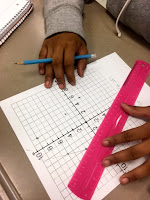
Several fascinating STEAM projects were developed in the environmental science and chemistry classes of GOPA and SOIT this fall. Using the new district-wide science curriculum,
these high school science teachers were able to collaborate, design, plan and implement their projects inspired by a variety of creative/scientific ideas found in Resource Folders provided in "Unit Zero." (For example see "Cards to the Sky Gummy Bear Challenge" described at the end of this post, marked with *)
Participating teachers included science teachers Mr. Schulties, Mr. Agyeman, Ms. Gilstrap, and Mr. Thompson (GOPA) and Ms. Sweet and Ms. Jarvis-Hicks (SOIT). These STEAM projects were intra-curricular because both environmental science and chemistry teachers did the same project. In addition, teachers were encouraged to improvise with the resource materials found in "Unit Zero" and adjust the activities based on their classroom needs. Art PIR Triada Samaras interviewed two of these teachers:
Environmental Science teacher Ms. Gilstrap explained:
"This was the "Zero" unit in our science curriculum. This unit emphasizes getting students interested in science and in scientific problems."
Chemistry teacher Mr. Schulties added:
"In my class, I gave the prompt to my students that they would be constructing a tower for a gummy bear village. I explained to them that the village has a number of different design requirements that needed to be met. For example, students
needed to create structures that would have to stand up to various physical
forces such as wind and gravity. In addition they needed to consider some aspects
of engineering such as height and weight."
"I then provided students with their materials including a deck of cards, a pair of scissors and a roll of scotch tape. I told them they needed to go and meet the requirements for each structure and to plan a presentation of their structure to the "Planning Board" (meaning, to me)."
 Mr. Schulties continued, "The rubric was built around how many requirements were met. Then, using these requirements, the classes collected date to determine a 'winner'. My students realized that even though the rubric requirements were met, there was still no clear winner. Thus they discovered the idea of qualitative data."
"Students understood their decision for a 'winner' would need to be determined qualitatively in addition to quantitatively. This was an important milestone for them. They learned the importance of collecting and analyzing both types of data in determining a solution to their problem. Thus, students could infer that by looking at the art behind an engineering project they could make quality structures that are very beautiful aesthetically. So what started out as an science/engineering lesson then his turned into a lesson of science PLUS design and aesthetics. The case for STEAM was clearly demonstrated in this project."
Mr. Schulties continued, "The rubric was built around how many requirements were met. Then, using these requirements, the classes collected date to determine a 'winner'. My students realized that even though the rubric requirements were met, there was still no clear winner. Thus they discovered the idea of qualitative data."
"Students understood their decision for a 'winner' would need to be determined qualitatively in addition to quantitatively. This was an important milestone for them. They learned the importance of collecting and analyzing both types of data in determining a solution to their problem. Thus, students could infer that by looking at the art behind an engineering project they could make quality structures that are very beautiful aesthetically. So what started out as an science/engineering lesson then his turned into a lesson of science PLUS design and aesthetics. The case for STEAM was clearly demonstrated in this project."
* “Cards to the Sky”
Gummy Bear Tower Challenge
(from the Resources provided in 'Unit Zero' by the Paterson School District for Science Teachers)
ROYAL-FLUSH, Inc., an architectural and structural
engineering firm, has a contract with the Bear Valley Community to design and
build the community's first skyscraper structure. You work for ROYAL-FLUSH, and
have been assigned to complete the project.
The following design requirements have been determined for
the structure:
DESIGN REQUIREMENTS
1) A height of 14 inches (this may seem a bit
short, but given that the average height of a Bear is ¾inch, this makes for a
pretty tall building in Bear terms).
2) A platform on the top of the structure that
will hold 6 Bears, for viewing lovely Bear Valley.
3) Stability through a hairdryer wind at 14
inches from a westerly direction. Designs that exceed this requirement are
acceptable too.
4) Pleasing to look at.
5) As small a mass as possible, since the
structure will be constructed off site, then trucked into the Valley for final
installation.
6) Construction materials: 1 standard deck of
playing cards, 1 roll of tape, a pair of scissors.
7) The final structure must contain the roll of
tape and the pair of scissors.
8) Completed construction in 45 minutes. This may
seem like a short period, but given that the life span on a Bear is only 2
days, there is no time to waste!
9) A three minute client presentation, where the
design features, rationale, and general
approach to solving the problem are discussed (chart paper and markers
supplied)
Your 3-minute
presentation should include:
- Basic
design approaches your team considered
- What
design requirements your team focused on
- The
estimated mass of your structure
- Proof
that the structure meets the wind requirement.
- How
your team spent its time
- Overall approach taken to solve the
problem (Provide a schematic that represents the process.)
Masses
The following information should help in estimating the mass
of your skyscraper:
Card Box = 5.13 g
1 Card = 1.63 g
5 Cards = 8.15 g
20 Cards = 32.60 g
Source: Sheppard, S. (2001). The compatibility (or
incompatibility) of how we teach engineering design and analysis. International
Journal of Engineering Education, 17(4-5), 440-445. Retrieved from http://www.ijee.ie/articles/Vol17-4and5/Ijee1234.pdf






























